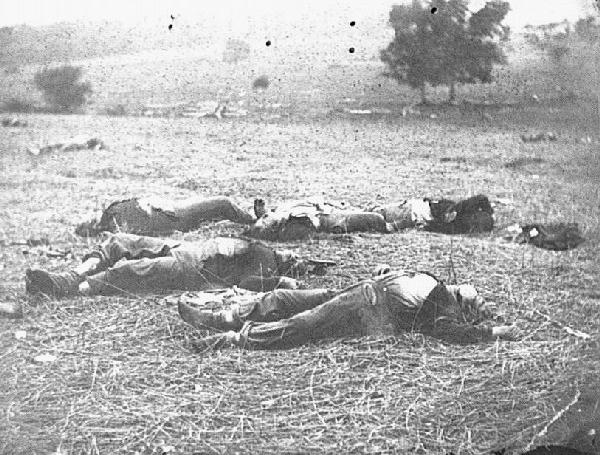“Those dead should not die in vain” (Abraham Lincoln) The bodies of four Union soldiers were captured in a photograph (https://www.historyplace.com/lincoln/lincpix/woods.jpg) lying lifeless on the grounds of a battlefield. At first glance, assumptions can be made that these innocent soldiers passed in vain—a violent death filled with no purpose. This assumption becomes the complete opposite once the context is added to the historical source and analyzed even further. Supporting Lincoln’s statement, the soldiers depicted did not die in vain but rather died with a purpose. To understand this purpose, one must become familiar with the significance of the battle in which these soldiers gave their lives. The ‘Battle of Gettysburg ‘ was fought between the Union and the Confederates (North vs. South) over Slavery during the Civil War. Think of the Union as soldiers fighting to abolish slavery, while the Confederates consisted of soldiers trying to keep Slavery existent in America.
Even though the picture was taken in black and white by an unknown photographer in 1863, the identities of the four soldiers were able to be discovered. The soldiers were a part of the 24th Michigan Infantry (Union Soldiers) and unfortunately lost their lives on the first day of battle. The photographer does a very good job shedding light on the purpose behind these soldiers who passed on the first day by using tactical concepts. The photograph was taken at an angle, representing not only the deceased four soldiers but also empty land further above. The land above was not empty and reflected around 15,000 other soldiers who also lost their lives on the exact same day. As mentioned above, the photo was taken in black and white, but the photographer made sure to shed light on the details of these soldiers, particularly through their uniforms. The visual composition of the source also helped emphasize this perspective that these soldiers died in battle, depicting the idea that they all believed in what they were fighting for. This purpose that the photographer is trying to emphasize is the idea that these Union Soldiers died while fighting to abolish Slavery in the United States, fighting for the freedom of others.
Gettysburg’s Bloody Wheatfield, written by Jay Jorgenson (https://search.ebscohost.com/login.aspxdirect=true&AuthType=sso&db=cat00991a&AN=sth.ocn881416018&site=eds-live), helps emphasize the purpose stated by the photographer by shedding light on how much these soldiers sacrificed and the heavy violence they entailed, which was responsible for much of their deaths. The way in which Jorgenson connects to death through the eyes of the soldier instantly sheds light on the way many interpreted deaths, emphasizing this belief that many soldiers were willing to give their lives for this freedom. Glenn F. LaFontaine furthers this idea through his book, “Gettysburg Heroes: Perfect Soldiers, Hallowed Ground” (https://search.ebscohost.com/login.aspxdirect=true&AuthType=sso&db=e900xww&AN=232236&site=eds-live) by emphasizing the hardships each soldier faced and how their motivation allowed them to continue a rather hard fight for a greater purpose. An interesting concept that LaFontaine did was define what it meant to serve through Lincoln’s perspective, which entailed the importance of ‘serving the whole country and not dying in vain.
Analyzing the photograph once given the context allows for a whole different meaning to form, one that emphasizes the visual components done by the photographer and the message they are trying to portray. Kent Gramm uses the same technique used by the photographer and connects photographs from the Battle of Gettysburg to the real-life perspectives of soldiers. His piece, “Gettysburg: The Living and the Dead (https://search.ebscohost.com/login.aspx?direct=true&AuthType=sso&db=e000xna&AN=2205884&site=eds-live.), depicts the true purpose of soldiers fighting and uses the pictures as a foundation to depict the true realities behind the ‘Battle of Gettysburg’. Each soldier, both ‘living and dead, contributed to the outcome of this battle and helped abolish slavery, which Gramm made sure to support. The bravery and sacrifice each and every soldier made will never be forgotten; the photograph just went on to confirm that. As Lincoln mentioned above and the photographer emphasized all throughout, ‘The dead should not die in vain’.
Glenn W. LaFantasie. 2008. Gettysburg Heroes: Perfect Soldiers, Hallowed Ground. Bloomington: Indiana University Press. https://search.ebscohost.com/login.aspx?direct=true&AuthType=sso&db=e900xww&AN=232236&site=eds-live.
Jorgensen, Jay. 2014. Gettysburg’s Bloody Wheatfield. Savas Publishing. https://search.ebscohost.com/login.aspx?direct=true&AuthType=sso&db=cat00991a&AN=sth.ocn881416018&site=eds-live.
Kent Gramm. 2019. Gettysburg: The Living and the Dead. Carbondale: Southern Illinois University Press. https://search.ebscohost.com/login.aspx?direct=true&AuthType=sso&db=e000xna&AN=2205884&site=eds-live.’
